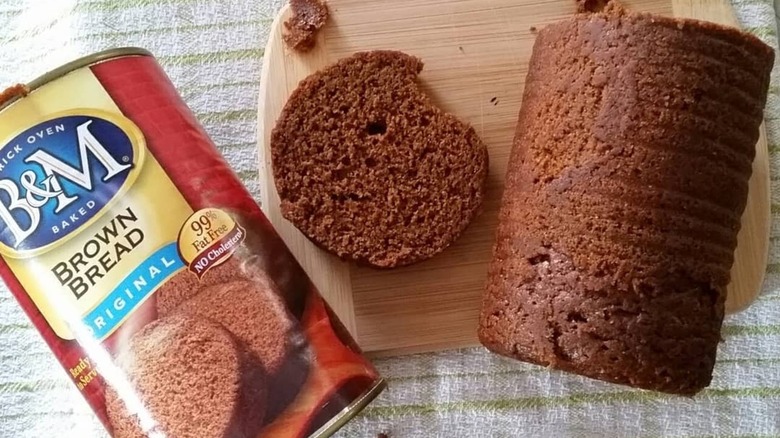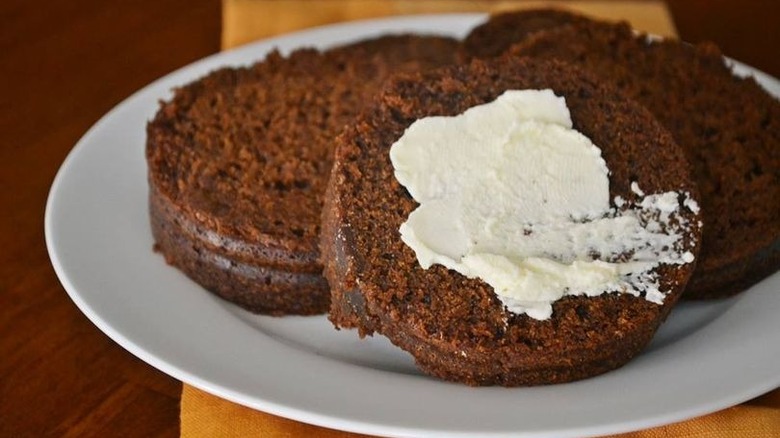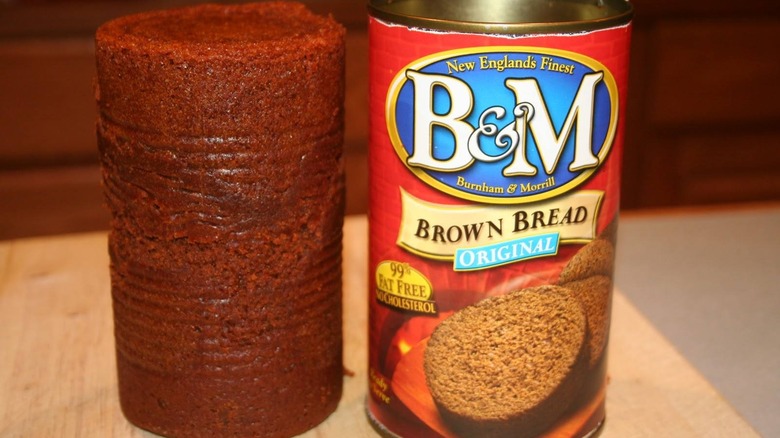What Does Canned Bread Really Taste Like?
Eating bread from a can might sound like crazy talk to some, but for natives of New England, it's a food steeped in nostalgia. For many families in the region, Saturday nights meant a dinner of Boston baked beans, hot dogs, and canned bread, and while the product's popularity has faded in recent decades, its mere mention still evokes strong opinions, both good and bad.
When people talk about canned bread, they are almost always referring to a specific brand — B&M Brown Bread — made by the same Maine-based company that is nationally renowned for its baked beans. It is essential to note that B&M Brown Bread and its imitators are completely different from traditional Irish brown bread, despite the region's strong ties to the Emerald Isle, but we're not here to tell you what it isn't; we're here to tell you what it is.
Canned foods get a bad rap these days, often associated with malicious preservatives and unhealthy additives, but B&M's ingredients list is actually very straightforward. It contains whole wheat flour, water, molasses, dextrose, rye flour, whey, corn meal, baking soda, buttermilk, salt, and corn oil. B&M also makes a version with raisins, which adds additional sweetness, but the flavor is really dominated by the marriage of molasses and rye, similar to the taste of pumpernickel bread. It's a polarizing flavor, leaving some with fond memories while others find it bland and forgettable. The one thing that everyone seems to agree on is that canned bread isn't really bread.
It's more like cake than bread
In truth, the term "canned bread" is a bit of a misnomer. Yes, it indeed comes in a can, just like B&M's other products, and when you slide it out, it has ridges, just like you see on canned cranberry sauce. However, most people who have tried it agree that "bread" is a poor descriptor. Its texture has much more in common with a cake or muffin than a loaf of sandwich bread or sourdough. It is leavened with baking soda rather than yeast, giving it a fairly dense crumb with very small air bubbles. Some find it to be a bit on the dry side, which is where additions like butter, jam, or a plate of baked bean liquid to sop up comes in handy.
Many online reviews compare B&M's canned brown bread with bran muffins, in terms of both texture and taste, which should give you a better idea of what you'll be in for when you eat it. The subtle sweetness of the molasses is what gives it a bran-like flavor. Other comments draw parallels to banana bread (without the bananas) and zucchini bread, both of which are traditionally made without yeast and lean more toward the texture of cake than a classic loaf of bread. For any readers familiar with British cuisine, steamed pudding is another useful comparison, which brings us to the reason canned bread exists in the first place.
Why put bread in a can to begin with?
New England-style brown bread dates back to the colonial era. The region's climate makes growing wheat extremely difficult, so corn and rye flours came to dominate the region's baked goods. The canned aspect also has colonial roots, evolving from an old cooking method. Few people in colonial New England had access to ovens, so cooking was done over an open fire. They couldn't bake bread the traditional way, so instead, they packed the ingredients into coffee tins or similarly shaped molds and steamed them.
In 1867, George Burnham and Charles Morrill founded B&M (named for their initials), initially canning meats and vegetables. In 1928, the company began making canned bread, keeping with the traditional steam-cooked method.
History has not been particularly kind to canned bread, which has seen a steady decline in popularity. New England-style brown bread was born out of necessity, but the steady expansion of transportation networks made wheat flour readily available to all parts of the country. Today, B&M produces less than one million cans of bread per year. Admittedly, the idea of eating canned bread can be a hard sell to those who didn't grow up with it, and it doesn't help that the flavor is a bit of an acquired taste. You can't be sure if you'll like it or not unless you try it, but you'll be hard pressed to find it in stores outside of New England. If you live elsewhere, your best bet is to search for canned bread online.


